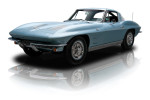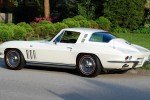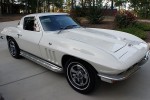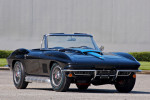This summer, we are talking “Generations”. Every week we’ve highlighted another Generation of Corvette. We have pictures, videos, and some great reading material on each Generation of Corvette. In this post, we look at the C2.

Between various concept and racing cars–the Mako Shark and Stingray among them — and the Vette’s rear-end redesign in ’61, Chevrolet stylists had been dropping hints for years about the future of Corvette styling. As had happened 10 years before with the very first Corvette, the dream cars became reality for the ’63 model year. But this time there were some significant engineering changes that went along with the Vette’s new look.
Sting Ray
Like a lot of overnight sensations, the groundbreaking redesign of the ’63 Corvette was years in the making. As far back as 1957, Chevrolet stylists penned a design study called the Q-Corvette, a coupe whose sleek silhouette had all of the ’63’s major styling elements. The concept was revised over the years through several iterations; the final version was designed by Larry Shinoda, who had also drawn up Bill Mitchell’s Stingray and the Mako Shark show car.
As had been the case with previous Corvettes, Mitchell incorporated some of his own design ideas into the body, most notably the pointed “stingers” at both ends of the car. A sharp-nosed bulge that flowed across the top of the hood was carried over the roof as a ridge-like crease that continued down to the car’s trailing edge, where the boattail-like roofline came to a sharp end. To ensure the continuity of the roof crease, the back glass was split in two pieces, leaving a channel in the roof for the crease to flow through. This design element was controversial to say the least, both within and outside of Chevrolet. Zora Arkus-Duntov, the Corvette’s chief engineer, reportedly hated it, critical of its negative effect on rearward visibility. Motor Trend called it “designed more for looks than practicality” and said, “Any decent view to the rear will have to be through an exterior side-view mirror.” The split window generated enough negative response that it was replaced with a conventional single window backlight for the ’64 model year.
Under the skin things were more harmonious — and far more advanced than in previous years. To improve the Corvette’s handling, Duntov had been experimenting with independent rear suspension designs on several concept cars, including his CERV I and II engineering prototypes. The IRS setup finally came to a production Corvette for ’63. Though Duntov wasn’t thrilled with the use of a transverse-mounted leaf-spring pack under the differential (in concept form, the IRS incorporated coilover shocks), he was very happy with the new Vette’s chassis design, calling the car, “a Corvette I can be proud to drive in Europe.”
The redesigned Corvette sat on a smaller wheelbase — 98 inches, down from 102 — and its ladder-style frame allowed passengers to sit lower in the car. For the first time, power brakes were offered as an option, as was power steering. “We thought the old model cornered darn well, but there’s no comparing it to this new one,” wrote Motor Trend‘s technical editor Jim Wright in the May 1963 issue. “It does take a little different technique, but once the driver gets into it, it’s beautiful.”
Chevy kept changes to the Corvette at a minimum for the ’64 model year. Mitchell’s split rear window disappeared, as did the faux louvers in the hood. New cylinder heads and a more aggressive cam brought the output of the top carbureted 327 from 340 hp to 365, while the fuel-injected version jumped from 360 hp to 375. Much bigger underhood news would come for the ’65 model year, with the introduction of two landmark Corvette engines: the L78 big-block and L79 small-block.
The 396ci Mark IV big-block was a descendant of the “Mystery Motor” 427 that Chevy campaigned in NASCAR in 1963. Nicknamed the “porcupine” engine because of the unusual valve configuration in the heads, the L78 was rated at 425 hp in the Corvette — though that was likely a conservative estimate on GM’s part.
Duntov and his team had labored hard to optimize the Corvette’s front/rear weight balance in the second-generation Vette, work one would think would be negated by the 396’s extra 150 pounds over the nose. But reviewers liked how well you could steer the Corvette with the throttle, thanks to the motor’s 415 lb-ft of torque. The eye-bleeding acceleration offered by the big engine seemed to offset any complaints of heavier steering effort and some understeer.
Buyers who didn’t need all that power and preferred a better balanced Corvette could now opt for three variations of the 327-inch small-block, including the new L79. Essentially a hydraulic-cammed version of the L76, it produced an honest 350 hp while proving to be more livable on the street than the solid-lifter L76. At the top of the small-block heap was the fuel-injected 327, but not for long; this was the last year for the fuelie motor.
Not every performance upgrade for ’65 was underhood. This was the first year the Corvette came standard with four-wheel disc brakes. Motor Trend’s Bob McVay called them “just great — the final component that gives an already good sports car stopping power to match its go power.” On the outside, the easiest way to tell a ’65 from a ’64 is to look at the front fenders: the ’64’s two horizontal louvers became three vertical louvers for ’65. This also marked the first year for the optional side pipes.
Following the “more is always better” rule, GM’s powertrain engineers bored the 396 out to 427 cubic inches for the ’66 model year, so the L78 option gave way to the mighty L72. With big ports in the heads, a solid-lifter camshaft, 11:1 compression and a 780-cfm Holley carb, the L72 was conservatively rated by Chevrolet at 425 hp, identical to the L78. Those in the know, though, realized that further up in the rev range, the motor was making more like 450 hp. Jerry Titus, who tested an L72 coupe with the close-ratio four-speed in the December 1965 issue of Sports Car Graphic, made the 0-60 sprint in 4.8 seconds and hit 100 mph in 11.2. He didn’t post a quarter-mile time, possibly because he borrowed the car from a local dealer and didn’t take it to a track. But according to his article, he didn’t need to: “All you need is a two-block-long straight. From a 70 mph cruising speed you can accelerate to the redline in top gear (140 mph) in roughly a mile. Sixty to 100 mph in top gear takes a mere 7.2 seconds. Tell us you’d like a hotter performing road machine than this and we’ll call you some kind of nut!” (Motor Trend put a 427 convertible — also with the close-ratio four-speed and 4.11 gears — through its full battery of tests, and in its March 1966 issue reported a 0-60 time of 5.6 seconds and a 13.4-second quarter-mile at 105 mph.) Less-nutty Corvette buyers had several other engines to choose from. The standard engine in ’66 was the 300hp L75 small-block; the L79 remained, and a 400-horse 427, the L36, was also available. The ’66 model saw a few exterior changes, too, including new wheels covers, a new egg-crate grille behind the bumper, a “Corvette” badge on the hood, and the removal of the vents on the coupe’s B-pillars.
Chevrolet originally planned to introduce the all-new, Mako Shark II-based third-generation Corvette in the ’67 model year, but the new car just wasn’t quite ready in time. So the second-gen model hung on for one more year. That didn’t mean, though, that Chevy made do with a carry-over ’66 Vette. No, Duntov and his crew made enough changes to vault the ’67 model from mere epilogue status to a car that is widely considered the best of the C2 generation.
Externally, the badges were shaved off the fenders, the hood script also disappeared, and a new set of fender louvers — five louvers raked forward — gave the car a more purposeful look. This year marked the first appearance of the five-slot steel Rally wheel, while the optional multi-blade cast-aluminum wheel lost its knock-off hub and bolted on conventionally. A new “stinger” hood was used on big-block models, some with stripes that either matched or complemented the car’s interior color. Under that stinger hood beat a 427-inch heart, but Chevy’s powertrain engineers yet again upgraded the big-cube mill. The ’66 L72 gave way to the L71, which replaced the single four-barrel with three Holley two-barrel carbs. Tri-power induction had been a mainstay of GM muscle cars for years, and in the Vette it boosted the 427’s rated output to 435 hp. (An L68 version of the 427, essentially the L36 with triple carbs, was rated at 400 hp.)
But Duntov wasn’t yet finished with the 427. Late in the model year came the L88, which topped the Mark IV four-bolt block with aluminum cylinder heads that offered big intake and exhaust ports and, working with the forged aluminum pistons, squished the compression ratio up to 12.5:1. A high-rise aluminum intake manifold was home to an 850-cfm Holley carb, which was topped by an unusual-looking air-cleaner assembly that sealed to the stinger hood (made functional for L88 applications). Again, Chevrolet conservatively rated the L88’s output at 430 hp, but its actual power peak was likely more than 500 hp. The L88 was intended as a race-only option, and it came with the M22 “Rock Crusher” Muncie four-speed, heater and radio deletes, heavy-duty suspension, Positraction, and metallic brakes. Just 20 Corvettes were sold with the L88 option in ’67, and many of these early cars were plagued with connecting-rod failures, a design flaw that was fixed for the ’68 model year.
The C2 was the shortest-lived Corvette generation of them all, yet the cars produced during those seminal years truly brought the marque up to world-class sports car status. By the close of C2 production, the Corvette was able to run with the best Europe had to offer, and it finally made Duntov proud.
Content (except pictures and video): Motor Trend





